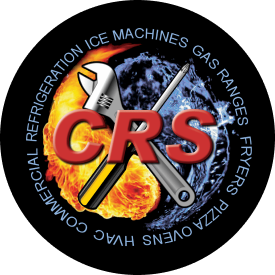Running a restaurant isn’t cheap. Expenses pile up. Whether it’s ingredients, staffing, utilities, or rent, one of your largest operating costs is going to be one thing: your restaurant’s commercial HVAC system.
Whether you’re operating a food truck or a full-service dining establishment with indoor, outdoor, and upstairs seating, those energy bills can skyrocket in the summer from high-running AC, and catch up to you in the winter with your furnace.
You can avoid some of it by doing three cost-saving practices with your HVAC unit. In today’s post, Commercial Restaurant Service in Springfield, Missouri, explains how.
How Much Energy Do Restaurant HVAC Units Consume?
Research shows that a full-service restaurant will use up the largest portion of energy (in British Thermal Units [Btu]) on food preparation (35%), and the second-highest usage is from a commercial HVAC unit (28%).
Why is Energy Efficiency Vital for Commercial Kitchens?
Commercial kitchens use up a lot of energy. Energy Star reports that an electric deep fryer uses more than 18,000 kilowatts per hour, while the average U.S. household uses 12,000 kWh per year.
As you can imagine, the cost can add up quickly. A major way to cut down on your energy bill and maintain a profitable operation is through a high-performing HVAC unit.
1. Get Regular Professional HVAC Maintenance Inspections
You’re busy running a restaurant – not troubleshooting HVAC issues! Leave it to the pros. The grease, grime, and muck from a kitchen impact your restaurant’s HVAC in numerous ways. It can be difficult to pinpoint the problem and solve it without hiring a third-party contractor to properly inspect it.
Scheduling regular maintenance for your kitchen’s AC unit is among the best ways to ensure your energy bill stays balanced and favorable all year long.
A poor-performing HVAC can lead to a 30% increase in monthly utility costs, according to EnergyStar. Expert HVAC technicians can diagnose exactly what the issue is. We factor in issues that pertain to the range hood, damaged ductwork, a blocked make-up air unit, or an overall poorly-designed HVAC system.
Commercial Restaurant Service ensures your restaurant’s HVAC stays energy efficient and profitable, performing consistently with smooth efficiency, and making your restaurant a comfortable place for customers and employees alike.
2. Change Your Air Filters Regularly
Make sure you buy spare air filters well in advance. You’ll need them. Kitchens are notorious for poor indoor air quality thanks to thick oils, greases, and various food particulates that clog air filters and prevent the HVAC system from performing optimally.
A dirty air filter forces your restaurant’s HVAC to work harder than normal, putting more stress and strain on it, decreasing its longevity, and skyrocketing your energy bill. That’s no good!
Unlike other more intensive HVAC issues, (damaged condenser coils, leaking refrigerant, or a broken motor fan) changing an air filter is pretty darn easy. But it’s just as easy to forget about it altogether.
You just need to remember to do it every couple of months (3 months or so). You can set reminders on your laptop or phone that notify you to perform an air filter switch every so often in case you forget.
3. Upgrade Your Thermostat
Manipulating your thermostat levels is an easy way to save money on your restaurant’s energy bill. You can also manually adjust your thermostat during low-volume times at your restaurant.
Lowering or raising your temps by 1 degree can save up to 4-5 percent in energy usage.
If you can, get a Smart thermostat that automatically adjusts temperature levels based on foot traffic and usage level. Security settings allow you to keep thermostat levels from being tampered with and give you full remote control over energy settings.
Energy-Saving Best Practices for Your Commercial Restaurant
- Understand your energy costs: Perform an audit with the help of an HVAC contractor to identify where your restaurant uses the most energy, then adjust your energy consumption accordingly.
- Update old appliances: If your HVAC is old and inefficient, replace it or replace the worn parts. The same goes for underperforming kitchen appliances (freezer, range hood, or dishwasher). We offer cost-effective refurbished kitchen equipment from choice brands.
- Switch to energy-efficient LED lighting: You can lower costs without breaking the bank by replacing your light fixtures with energy-efficient LED bulbs. You can also install motion sensors in bathrooms or closets to turn off the lights when they’re not being used.
- Use appliances efficiently: Refrigeration and refrigerators consume the bulk of a restaurant’s energy and can put pressure on an HVAC unit to keep up. Don’t leave refrigerator doors ajar, or pack items near vents to block air pressure and circulation.
- Check with your utility company for rebates: If you’re buying new equipment, call your utility provider to see if they offer any financial incentives for energy-efficient commercial restaurant appliances.
Find the Best Restaurant HVAC Repair & Maintenance Services at 417CRS
Our Springfield, Missouri-based HVAC contractors can help accurately diagnose and repair any HVAC issue you may be having in your restaurant or food truck. We’re here to help your kitchen run smoothly, and efficiently. Schedule HVAC repair today at (417) 224-2614.
